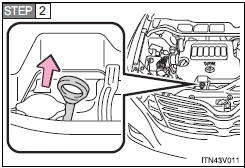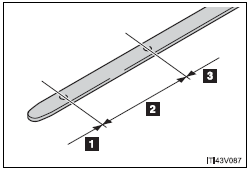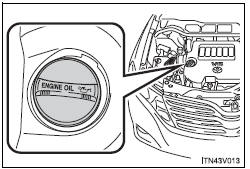Toyota Venza: Engine oil
With the engine at operating temperature and turned off, check the oil level on the dipstick.
- Checking the engine oil
 Park the vehicle on level ground.
Park the vehicle on level ground.
After warming up the engine and turning it off, wait more than five minutes for
the oil to drain back into the bottom of the engine.

Hold a rag under the end and pull the dipstick out.
 Wipe the dipstick clean.
Wipe the dipstick clean.
 Reinsert the dipstick fully.
Reinsert the dipstick fully.
 Holding a rag under the end, pull
Holding a rag under the end, pull
the dipstick out and check the oil level.
► Flat dipstick

1. Low
2. Normal
3. Excessive
The shape of the dipstick may differ depending on the type of vehicle or engine.
► Non-flat dipstick

1. Low
2. Normal
3. Excessive
The shape of the dipstick may differ depending on the type of vehicle or engine.
 Wipe the dipstick and reinsert it
Wipe the dipstick and reinsert it
fully.
- Adding engine oil

If the oil level is below or near the low level mark, add engine oil of the same type as already in the engine.
Make sure to check the oil type and prepare the items needed before adding oil.

 Remove the oil filler cap.
Remove the oil filler cap.
 Add engine oil slowly, checking
Add engine oil slowly, checking
the dipstick.
 Install the filler cap, turning
Install the filler cap, turning
it clockwise.
- Engine oil consumption
A certain amount of engine oil will be consumed while driving. In the following situations, oil consumption may increase, and engine oil may need to be refilled in between oil maintenance intervals.
• When the engine is new, for example directly after purchasing the vehicle or after replacing the engine • If low quality oil or oil of an inappropriate viscosity is used • When driving at high engine speeds or with a heavy load, when towing, or when driving while accelerating or decelerating frequently • When leaving the engine idling for a long time, or when driving frequently through heavy traffic
CAUTION
- Used engine oil
• Used engine oil contains potentially harmful contaminants which may cause skin disorders such as inflammation or skin cancer, so care should be taken to avoid prolonged and repeated contact. To remove used engine oil from your skin, wash thoroughly with soap and water.
• Dispose of used oil and filters only in a safe and acceptable manner. Do not dispose of used oil and filters in household trash, in sewers or onto the ground.
Call your Toyota dealer, service station or auto parts store for information concerning recycling or disposal.
• Do not leave used engine oil within the reach of children.
NOTICE
- To prevent serious engine damage
Check the oil level on regular basis.
- When replacing the engine oil
• Be careful not to spill engine oil on the vehicle components.
• Avoid overfilling, or the engine could be damaged.
• Check the oil level on the dipstick every time you refill the vehicle.
• Be sure the engine oil filler cap is properly retightened.
 Engine compartment
Engine compartment
► 2GR-FE engine
1. Engine coolant reservoir
2. Engine oil filler cap
3. Engine oil level dipstick
4. Brake fluid reservoir
5. Battery
6. Fuse box
7. Electric cooling fans
8. Condenser
...
 Engine coolant
Engine coolant
The coolant level is satisfactory if it is between the “F” and “L” lines on the
reservoir when the engine is cold.
1. Reservoir cap
2. Full
3. Low
If the level is on or below the “Lâ ...
Other materials about Toyota Venza:
Calibration
CALIBRATION
1. ROTATION ANGLE SENSOR INITIALIZATION AND TORQUE SENSOR ZERO POINT CALIBRATION
NOTICE:
Clear the rotation angle sensor calibration value, initialize the rotation angle
sensor, and calibrate the torque sensor zero point if any of the followin ...
All Door Entry Lock/Unlock Functions and Wireless Functions do not Operate
DESCRIPTION
When the entry door lock and unlock functions and wireless door lock and unlock
functions do not operate, radio wave interference, or a malfunction in the key or
signal circuit between the door control receiver assembly and certification ECU
...
How To Proceed With Troubleshooting
CAUTION / NOTICE / HINT
HINT:
Use the following procedure to troubleshoot the LIN communication system.
*: Use the Techstream.
PROCEDURE
1.
VEHICLE BROUGHT TO WORKSHOP
NEXT
...
0.1708
